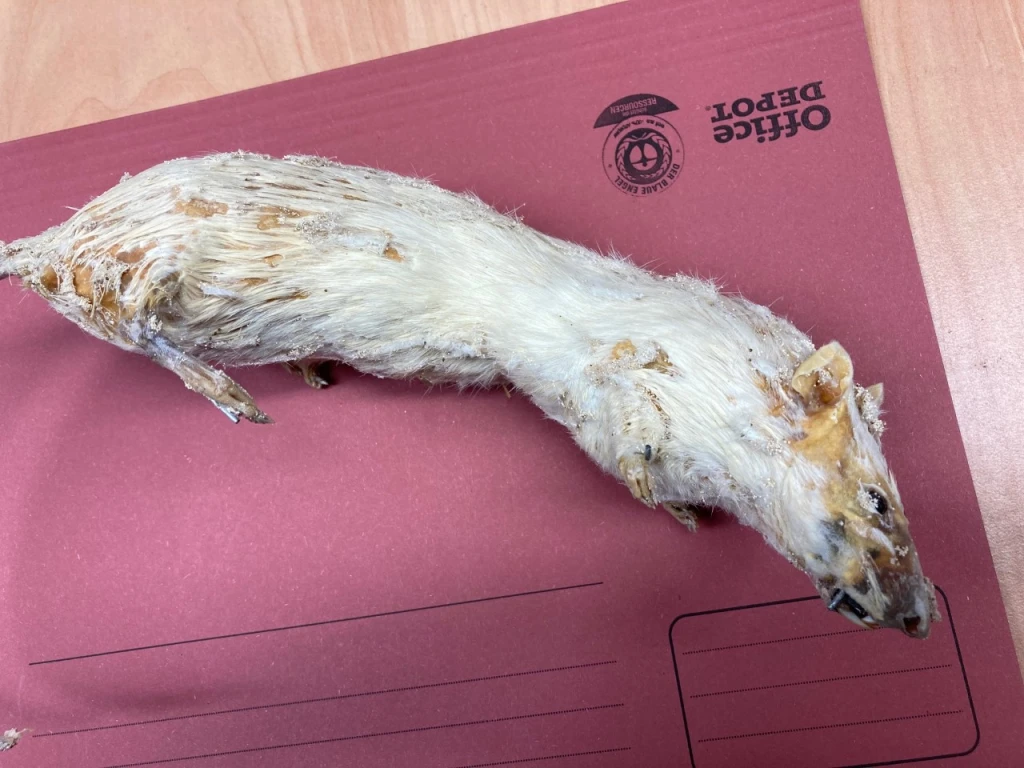Dr Alice Would (University of Bristol) discusses the temporalities of taxidermy following an encounter with a rotting rat, which is pictured below.
In January 2022, I received an email from my former PhD supervisor, the environmental historian Peter Coates, asking what I wanted to do with my attempt at taxidermy. This was a white rat, or rather, ‘now very sorry looking Mr Rat.’ Peter was packing up his office ahead of retirement when he rediscovered the rat’s bodily remains inside a plastic bag. We had taken a taxidermy course together in 2018; I was researching the processes and materialities of Victorian taxidermy and we thought it would be a useful exercise to trial practice-informed historical research. As I reflected in an essay for Environmental History Now, my own embodied experience was inextricable from my practice.[i] I was a knot of nerves, my ethics were challenged, and my fingers wouldn’t do what I asked of them – the coordination needed for taxidermy is considerable.

I learned how taxidermy has always been a multisensory confrontation and discovered a great deal about the technicalities of Victorian practice: de-fleshing, looping wires, and cupping stuffing in the palm of the hand so that it sits within the animal skin as flesh would. However, and perhaps most significantly, I also encountered the barriers standing in the way of embodying a Victorian taxidermist. My practice was very much of the present, and I took my own worries, preconceptions, intentions, and lack of skill with me when I met with the rat’s skin. These feelings stayed with me: I was unsettled by the experience, and the way the smell of death clung to my fingers, and I therefore continued to keep a purposeful distance between myself and the rat and this is how he ended up residing in Peter’s office. With the onset of the COVID-19 pandemic, Mr Rat was packed away in a bag on a high shelf.
Over the course of my research, I kept coming across the processes of decay within the writing of hunters and taxidermists, and, consequently, rot, epidermic breakdown, and time became central themes, winding their way through my thesis. Everywhere I looked, from diary entries about skinning and preparing specimens within the colonial hunting grounds of East Africa, to museum records from both the turn of the twentieth century and the present day, I found descriptions of animal specimens hosting insects and bacteria. The British hunter Charles Peel noted how obsessively he watched-over his animal skins when travelling and shooting in the British Protectorate of Somaliland in the 1880s as ‘the ravages made by a little grub-beetle were terrible.’[ii]
Roughly a hundred years later, a curator at the Royal Albert Memorial Museum in Exeter, Devon (the museum Peel donated many of his specimens to), similarly described the ‘ravages’ of so-called museum pests, and their specific effects on the taxidermy within the Peel collection.[iii] I was struck by the entropy revealed in such statements. Taxidermy is always undertaken in an attempt to preserve an animal in time and body, and it is often conceptualised as ‘freezing’ the animal, and yet these sources also spoke of an accelerated disintegration, and of the circling processes by which death supports life. Consequently, I reflected on the ways in which time is embodied, and how the histories and temporalities of hunting and taxidermy might contribute to our thinking on the Anthropocene.
Somehow, though, it was still a shock when my rat rotted, despite my clear lack of skill when putting him together; it isn’t often that we encounter decay in our sanitised present.[iv] A week or so after he emailed, I met Peter to find out for myself what ‘very sorry looking’ looked like. It was the first time I had been into his office since the pandemic introduced us all to an abrupt new experience of time. The rat was both hardened and crumpling, a fading white-yellow body just visible within the sweaty plastic. Moths the colour of sand traversed the skin surface, I could make out clutches of eggs clinging to the places where hair had once grown. I was disgusted, but it also felt like a fitting end to my PhD and this period of thinking about lively death in the past. The rat was a tiny living landscape within the wider ecosystem of Peter’s office with its books, papers and maps, animal skulls, lumps of wood, tea caddies and view of nesting squirrels.

The question remained of what to do with these disconcerting animal remains, and we decided to dispose of the rat. Whilst I felt a little compelled to see this temporal process through to the bitter end, neither of us could stomach the practicalities. The rat confirmed my thinking that, as environmental historians, we should endeavour to follow the traces of liveliness when they are offered up by our sources. Even within the most unpromising of case studies, for instance the tales of extraction, extinction and death that are central to museum collection, environmental actors were not necessarily entirely deadened and silenced. They were sites of multispecies exchange, and often continued to play a role in shaping peoples’ emotions and actions – and their experience of time.
Dr Alice Would is a lecturer in Imperial and Environmental History at the University of Bristol. She completed her PhD on the taxidermy trade in the long nineteenth century in Britain and empire in 2021.
[i] Alice Would, ‘Sensing Taxidermy in the Present’, Environmental History Now (2019)
[ii] Charles Peel, Somaliland: Being an Account of Two Expeditions into the Far Interior, Together with a Complete List of Every Animal and Bird Known to Inhabit that Country, and a List of the Reptiles Collected by the Author (London: F. E. Robinson & Co, 1900), 118-9.
[iii] Letter to the Oxford Theatre, 2 May 1996, RAMM Archive.
[iv] For more on rot see: Caitlin DeSilvey, Curated Decay (Minneapolis: University of Minnesota Press, 2017); Jamie Lorimer, ‘Rot’, Environmental Humanities, 8 (2016), 235–39.

